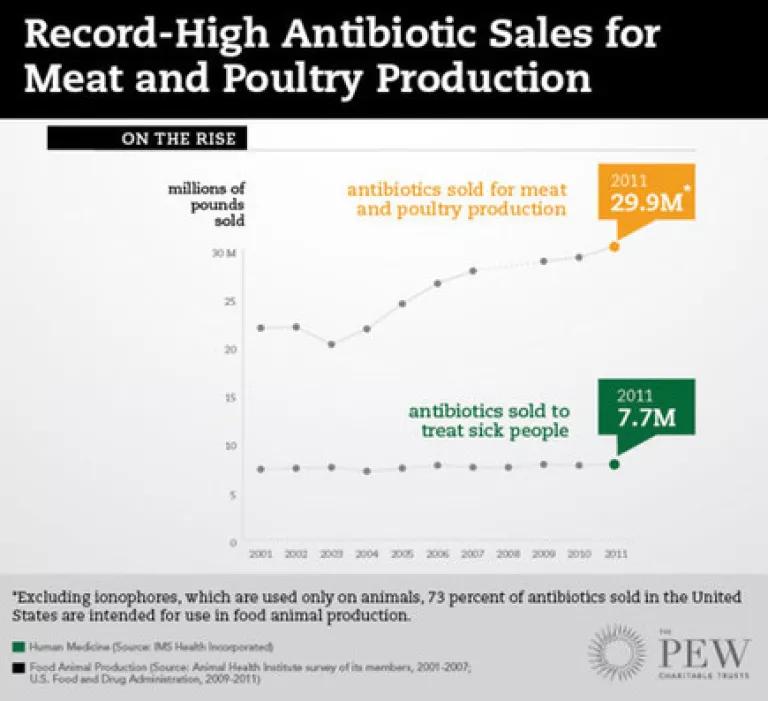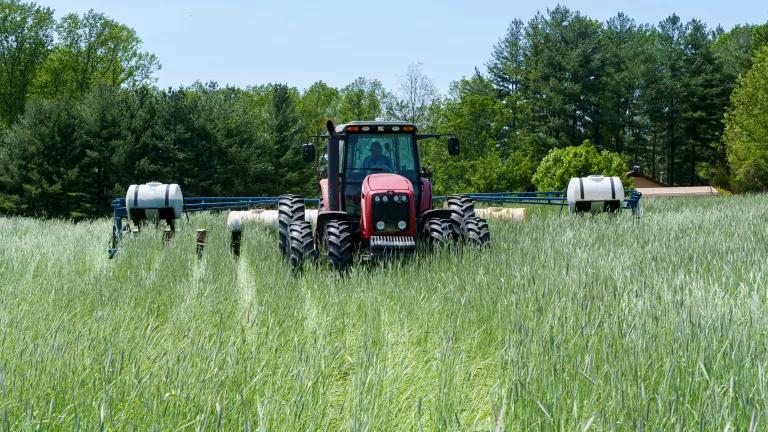According to the FDA’s latest data, the amount of antibiotics sold to the livestock industry in 2011 was almost four times the amount sold to treat people. While sales of antibiotics for human use has remained fairly constant over the last decade, the amount of drugs sold for meat and poultry production—mainly to speed up growth and compensate for cramped, unsanitary conditions on factory farms--has been increasing steadily.

Credit: The Pew Charitable Trusts
More than 30 years ago, the FDA--the agency tasked with ensuring the safety of our food supply--found that the practice of routinely dosing healthy livestock with antibiotics posed a threat to human health. In the 1970s, the FDA determined that this practice encouraged the growth of drug-resistant superbugs. These harmful bacteria could enter the surrounding environment and the food supply, where they could make people sick with infections that defied treatment with basic antibiotics.
Yet to this day, in the face of two federal court decisions and its own assessment of the evidence, the FDA has failed to take decisive action to stop this practice. What’s more, the FDA is continuing to fight, claiming the court should defer to the agency’s judgment on how to deploy its own resources.
We think, after 35 years of delay, neither the courts nor anyone else should be deferring to the FDA’s “judgment.”
The FDA’s unwillingness to act on antibiotic abuse is all the more outrageous when you consider the data the agency itself released last week. The numbers clearly show that antibiotics use in factory farms has steadily grown over time. And according to the latest test results from the federal government, retail meat and poultry are consistently contaminated with superbugs. In this year’s National Antimicrobial Resistance Monitoring System (NARMS) report, also released last week, almost half the E. coli samples found on meat were antibiotic resistant. Nearly half the Campylobacter-contaminated chicken samples were resistant to the antibiotic tetracycline. More than 27 percent of the chicken samples contaminated with Salmonella showed resistance to five or more classes of antibiotics.
When a bug is tough enough to withstand multiple classes of antibiotics, treatment options can become limited. An illness that in the past was cured with a common antibiotic suddenly requires more potent medicines and sometimes hospitalization. Medical experts warn that the rising tide of antibiotic resistance could mean that something as treatable as strep throat turns into a life-threatening disease. Doctors, stripped of some of the most powerful tools in their profession, find themselves reaching for stronger and often more toxic drugs, or that their hands are tied. Costs, suffering, and worries escalate.
“A post-antibiotic era means, in effect, the end of modern medicine as we know it,” Margaret Chan, Director General of the World Health Organization, recently told The Telegraph.
Factory farms have become reservoirs for the breeding of antibiotic-resistant bacteria. When these superbugs leave the farm, through polluted water and air, or on the hands and clothes of farm workers, there’s virtually no limit to where they can go—they can get not just into food but into homes, schools, and hospitals. According to the Infectious Diseases Society of America (ISDA), tens of thousands of Americans die from antibiotic-resistant bacterial infections every year. Antibiotic-resistant infections are estimated to cost up to $26 billion in additional health care costs each year.
Nearly every major medical group in the country has expressed concern about antibiotic abuse in the livestock industry. The American Medical Association, the American Academy of Pediatrics, and many other public health organizations have called for an end to the misuse of important antibiotics in livestock production. Congresswoman Louise Slaughter has introduced legislation, the Preservation of Antibiotics for Medical Treatment Act, aimed at curbing the practice. The World Economic Forum recently identified the rise of antibiotic-resistant bacteria as a major global risk, saying “…antibiotics are over-used around the world in livestock and fish farming (e.g. as growth promoters).”
The FDA’s failure to tackle the issue of antibiotic abuse on factory farms is pushing us toward a public health crisis. Yet the agency, in blatant disregard of the facts, continues to stand up in court and claim that it’s doing its job.
We need to preserve antibiotics for sick people. It’s time for the FDA to take action and stop antibiotic abuse on factory farms.



